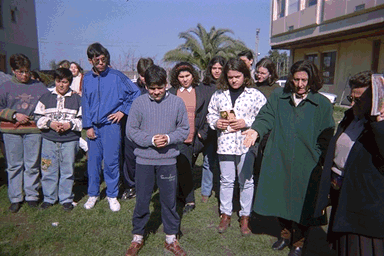Italiano |
[ Labs in network | University researchers | Schools and teachers | Present year's works | Materials produced ]
| Initial discussion: We asked ourselves the following two questions: - What about the light? [We discussed about this problem and we came to the conclusion that we need light to see, heat and live]. - What is needed for seeing ? [The eye, the object and...the light] Finally we classify the light sources in natural and artificial ones and also in primary and secondary ones. |
 |
The system under study is: source, object, eye and light between them. What does the light do ? What does the eye see? We carried out the first experiments using Plexiglas thin plates of different colours: we were able to classify materials by observing them.
What does the eye see?
I see very well through:
- a thin plate of white transparent Plexiglas
- a thin sheet of paper
- a veil
I see dim through:
- a thin plate of white Plexiglas
I don’t see through:
- many plates of white transparent Plexiglas
- many thin sheets of paper
- many veils
From the first and the second cases, we learned that the
materials can be : translucent and transparent. From the third
case we also understood influence of thickness.
What does the light do?
The light goes along a straight path until it meets a
thin plate of Plexiglas.
In this case:
- part of it goes across the thin plate of Plexiglas (
refraction)
- part of it is absorbed by thin plate of Plexiglas ( absorption
)
- part of it bounced back against the surface of the thin plate
of Plexiglas ( reflection)
These three phenomena always happen simultaneously, but in some
materials is observed that:
- a big quantity of light goes across the material ( transparency
)
- a big quantity of light remains inside ( opacity )
When the number of plates of Plexiglas grows, the thickness
increases, the light that gets through decreases and the quantity
of light that remains inside increases.
We thought that the light decrease would follow a linear law.
We measured the light intensity transmitted trough different
thickness with a sensor, using a projector as source.
We collected data in a table and we plotted the intensity versus
the distance: the law is not linear; the graph resembles that of
an iperbola..
We have also studied the reflection both with thin plates of
transparent Plexiglas and with mirrors (dependence of the light
intensity of the reflected image on the angle of reflection,
first and second law of the reflection, reflection as symmetry).
Finally we tried to connect this work with the phenomena that
occur when the solar radiation hits the atmosphere
and goes across it.
Aiello Carlo, Aiello Marco, Amendola Carmela, Amitrano Viviana, Arnese Pasquale, Astarita Carmine, Aversa Antonella, Cacace Ilaria, Cervogni Marianna, Dare Eva, D'Esposito Domenico, Esposito Salvatore, Gargiulo Rosaria, Jaccarino M. Teresa, Lombardo Francesco, Massa Giuseppina, Navarretta Paolo, Ponticorvo Michele, Ponticorvo Rosalia, Ruggiero Rosa, Savarese Donato, Scafi Stefania.